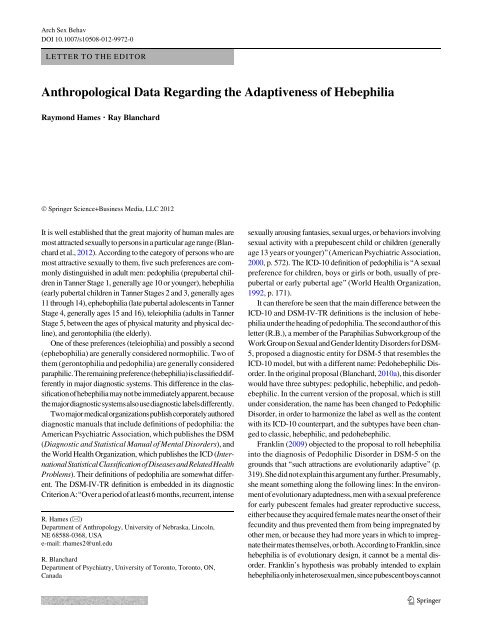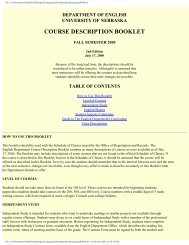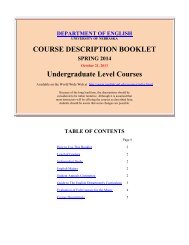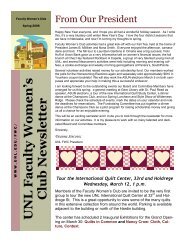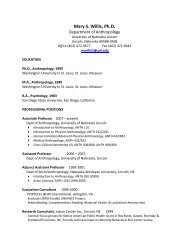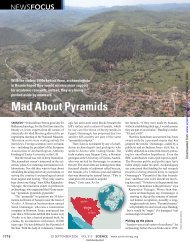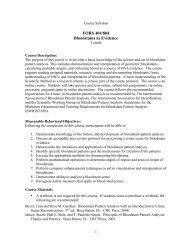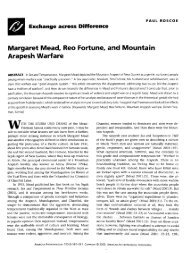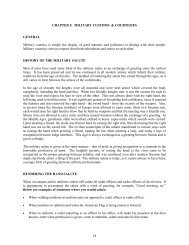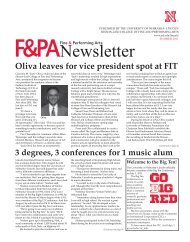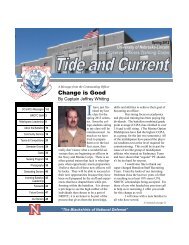Anthropological Data Regarding the Adaptiveness of Hebephilia
Anthropological Data Regarding the Adaptiveness of Hebephilia
Anthropological Data Regarding the Adaptiveness of Hebephilia
You also want an ePaper? Increase the reach of your titles
YUMPU automatically turns print PDFs into web optimized ePapers that Google loves.
Arch Sex Behav<br />
DOI 10.1007/s10508-012-9972-0<br />
LETTER TO THE EDITOR<br />
<strong>Anthropological</strong> <strong>Data</strong> <strong>Regarding</strong> <strong>the</strong> <strong>Adaptiveness</strong> <strong>of</strong> <strong>Hebephilia</strong><br />
Raymond Hames • Ray Blanchard<br />
Ó Springer Science+Business Media, LLC 2012<br />
It is well established that <strong>the</strong> great majority <strong>of</strong> human males are<br />
most attracted sexually to persons in a particular age range (Blanchard<br />
et al., 2012). According to <strong>the</strong> category <strong>of</strong> persons who are<br />
most attractive sexually to <strong>the</strong>m, five such preferences are commonly<br />
distinguished in adult men: pedophilia (prepubertal children<br />
in Tanner Stage 1, generally age 10 or younger), hebephilia<br />
(early pubertal children in Tanner Stages 2 and 3, generally ages<br />
11 through 14), ephebophilia (late pubertal adolescents in Tanner<br />
Stage 4, generally ages 15 and 16), teleiophilia (adults in Tanner<br />
Stage 5, between <strong>the</strong> ages <strong>of</strong> physical maturity and physical decline),<br />
and gerontophilia (<strong>the</strong> elderly).<br />
One <strong>of</strong> <strong>the</strong>se preferences (teleiophilia) and possibly a second<br />
(ephebophilia) are generally considered normophilic. Two <strong>of</strong><br />
<strong>the</strong>m (gerontophilia and pedophilia) are generally considered<br />
paraphilic.Theremainingpreference(hebephilia)isclassifieddifferently<br />
in major diagnostic systems. This difference in <strong>the</strong> classification<strong>of</strong>hebephiliamaynotbeimmediatelyapparent,because<br />
<strong>the</strong>majordiagnosticsystemsalsousediagnosticlabelsdifferently.<br />
Twomajormedicalorganizationspublishcorporatelyauthored<br />
diagnostic manuals that include definitions <strong>of</strong> pedophilia: <strong>the</strong><br />
American Psychiatric Association, which publishes <strong>the</strong> DSM<br />
(Diagnostic and Statistical Manual <strong>of</strong> Mental Disorders), and<br />
<strong>the</strong> World Health Organization, which publishes <strong>the</strong> ICD (InternationalStatisticalClassification<strong>of</strong>DiseasesandRelatedHealth<br />
Problems). Their definitions <strong>of</strong> pedophilia are somewhat different.<br />
The DSM-IV-TR definition is embedded in its diagnostic<br />
CriterionA:‘‘Overaperiod<strong>of</strong>atleast6 months,recurrent,intense<br />
R. Hames (&)<br />
Department <strong>of</strong> Anthropology, University <strong>of</strong> Nebraska, Lincoln,<br />
NE 68588-0368, USA<br />
e-mail: rhames2@unl.edu<br />
R. Blanchard<br />
Department <strong>of</strong> Psychiatry, University <strong>of</strong> Toronto, Toronto, ON,<br />
Canada<br />
sexually arousing fantasies, sexual urges, or behaviors involving<br />
sexual activity with a prepubescent child or children (generally<br />
age 13 years or younger)’’(American Psychiatric Association,<br />
2000, p. 572). The ICD-10 definition <strong>of</strong> pedophilia is‘‘A sexual<br />
preference for children, boys or girls or both, usually <strong>of</strong> prepubertal<br />
or early pubertal age’’ (World Health Organization,<br />
1992, p. 171).<br />
It can <strong>the</strong>refore be seen that <strong>the</strong> main difference between <strong>the</strong><br />
ICD-10 and DSM-IV-TR definitions is <strong>the</strong> inclusion <strong>of</strong> hebephiliaunder<br />
<strong>the</strong>heading <strong>of</strong> pedophilia. Thesecondauthor <strong>of</strong> this<br />
letter (R.B.), a member <strong>of</strong> <strong>the</strong> Paraphilias Subworkgroup <strong>of</strong> <strong>the</strong><br />
WorkGrouponSexualandGenderIdentityDisordersforDSM-<br />
5, proposed a diagnostic entity for DSM-5 that resembles <strong>the</strong><br />
ICD-10 model, but with a different name: Pedohebephilic Disorder.<br />
In <strong>the</strong> original proposal (Blanchard, 2010a), this disorder<br />
would have three subtypes: pedophilic, hebephilic, and pedohebephilic.<br />
In <strong>the</strong> current version <strong>of</strong> <strong>the</strong> proposal, which is still<br />
under consideration, <strong>the</strong> name has been changed to Pedophilic<br />
Disorder, in order to harmonize <strong>the</strong> label as well as <strong>the</strong> content<br />
with its ICD-10 counterpart, and <strong>the</strong> subtypes have been changed<br />
to classic, hebephilic, and pedohebephilic.<br />
Franklin (2009) objected to <strong>the</strong> proposal to roll hebephilia<br />
into <strong>the</strong> diagnosis <strong>of</strong> Pedophilic Disorder in DSM-5 on <strong>the</strong><br />
grounds that ‘‘such attractions are evolutionarily adaptive’’ (p.<br />
319).Shedidnotexplainthisargumentanyfur<strong>the</strong>r.Presumably,<br />
she meant something along <strong>the</strong> following lines: In <strong>the</strong> environment<strong>of</strong>evolutionaryadaptedness,menwithasexualpreference<br />
for early pubescent females had greater reproductive success,<br />
ei<strong>the</strong>rbecause<strong>the</strong>yacquiredfemalematesnear<strong>the</strong>onset <strong>of</strong><strong>the</strong>ir<br />
fecundity and thus prevented <strong>the</strong>m from being impregnated by<br />
o<strong>the</strong>r men, or because <strong>the</strong>y had more years in which to impregnate<strong>the</strong>irmates<strong>the</strong>mselves,orboth.AccordingtoFranklin,since<br />
hebephilia is <strong>of</strong> evolutionary design, it cannot be a mental disorder.<br />
Franklin’s hypo<strong>the</strong>sis was probably intended to explain<br />
hebephiliaonlyinheterosexualmen,sincepubescentboyscannot<br />
123
Arch Sex Behav<br />
becomepregnantanymorereadilythanprepubescentboys.Inany<br />
event, she did not address why homosexual pedophilia might be<br />
considered a disorder but homosexual hebephilia should not.<br />
Franklin’s hypo<strong>the</strong>sis was tested by Blanchard (2010b), who<br />
compared <strong>the</strong> mean numbers <strong>of</strong> biological children reported by<br />
818 heterosexual teleiophiles, 622 heterosexual hebephiles, and<br />
129 heterosexual pedophiles. The results showed that <strong>the</strong> teleiophiles<br />
had significantly more children than <strong>the</strong> hebephiles,<br />
and <strong>the</strong> hebephiles had significantly more children than <strong>the</strong> pedophiles.<br />
Blanchard (2010b), who had pointed out that <strong>the</strong>re is<br />
nothing in <strong>the</strong> contemporary environment that would completely<br />
abolish <strong>the</strong> relation between hebephilia and fertility postulated<br />
by Franklin for <strong>the</strong> ancestral environment, concluded that<br />
<strong>the</strong>re was no empirical basis for <strong>the</strong> hypo<strong>the</strong>sis that hebephilia<br />
was associated with increased reproductive success in <strong>the</strong> environment<br />
<strong>of</strong> evolutionary adaptedness.<br />
Franklin(2010)criticizedBlanchard’s(2010b)empiricaltest<br />
<strong>of</strong>herhypo<strong>the</strong>sis.Sheincluded,amongherobjections,<strong>the</strong>assertionthat‘‘Plungingbirthratesindevelopednationsalonecreatea<br />
low ceiling effect for this outcome variable’’(p. 819). The relevance<strong>of</strong>thisobjectionisunclear.Itisobviousthataceilingeffect<br />
might explain a failure to find that hebephilic men have significantly<br />
more <strong>of</strong>fspring than teleiophilic men, but it cannot<br />
explainwhyhebephilicmenactuallyhavesignificantlyfewer<strong>of</strong>fspring<br />
than teleiophilic men.<br />
Franklin’s notion about <strong>the</strong> ‘‘evolutionary adaptiveness’’ <strong>of</strong><br />
hebephilia continues to be echoed by o<strong>the</strong>r authors (see Blanchard,<br />
2012). The present writers <strong>the</strong>refore undertook to consider<br />
this notion fur<strong>the</strong>r. The problem we face in examining <strong>the</strong><br />
empirical and logical bases <strong>of</strong> potential evolutionary rationales<br />
for <strong>the</strong> adaptiveness <strong>of</strong> hebephilia is that <strong>the</strong>y are not adequately<br />
elaborated or documented. We notesome<strong>of</strong><strong>the</strong>specificlimitations<br />
as we evaluate <strong>the</strong> evidence below.<br />
In her original article, Franklin (2009) cited Kenrick and<br />
Keefe (1992) to support her hypo<strong>the</strong>sis that hebephilia (which<br />
she treats as synonymous with any detectable degree <strong>of</strong> sexual<br />
attraction to pubescent girls) is‘‘evolutionarily adaptive’’(p. 319).<br />
Kenrick and Keefe’s survey, however, says nothing about <strong>the</strong><br />
attractiveness<strong>of</strong>girlstomen.Thefocusisonattractiontowomen<br />
<strong>of</strong> various ages, and <strong>the</strong> facts that men prefer women a few years<br />
youngerthan<strong>the</strong>yareandwomenprefermenwhoareafewyears<br />
older.Aninterestingfindinginthatsurveyisthat,asmenage,<strong>the</strong><br />
age <strong>of</strong> <strong>the</strong> women <strong>the</strong>y prefer also increases, thus directly contradicting<br />
Franklin’s <strong>the</strong>sis. Kenrick and Keefe <strong>the</strong>n go on to<br />
develop an evolutionaryrationaleforwhymen should shift <strong>the</strong>ir<br />
agepreferencesthroughtime.Thus,KenrickandKeefe’ssurvey<br />
providesstrongevidenceagainstFranklin’sadaptationisthypo<strong>the</strong>sis<br />
<strong>of</strong> hebephilia.<br />
Ina Psychiatric Times blog post entry, Frances (2011) claims<br />
that<br />
The basic issue is that sexual attraction to pubescent<br />
youngsters is not <strong>the</strong> slightest bit abnormal or unusual.<br />
Until recently, <strong>the</strong> age <strong>of</strong> consent was age 13 years in most<br />
parts<strong>of</strong><strong>the</strong>world(including<strong>the</strong>UnitedStates)anditremains<br />
14 in many places. Evolution has programmed humans to<br />
lust for pubescent youngsters–our ancestors did not get<br />
to live long enough to have <strong>the</strong> luxury <strong>of</strong> delaying reproduction.…It<br />
is natural and no sign <strong>of</strong> mental illness to feel<br />
sexual attraction to pubescent youngsters.<br />
Although it is true, as Frances notes, that pubescent girls can<br />
bemarriedor betro<strong>the</strong>dinsome societies,thisdoesnotmeansex<br />
occurredatmarriageorbetrothalorthatsuchgirlswereregarded<br />
as more sexually desirable than physically mature women.<br />
Thereisverylittlecross-culturaldataon<strong>the</strong>topic<strong>of</strong>whe<strong>the</strong>rmarried<br />
pubescent girls had sex with <strong>the</strong>ir husbands. The best information<br />
we have is from Whiting’s (2009) work on maidenhood.<br />
Whiting defined maidenhood as <strong>the</strong> interval between menarche<br />
andmarriage.Afterexamining<strong>the</strong>HumanRelationsAreaFiles(a<br />
data base <strong>of</strong> world cultures studied by ethnographers), Whiting<br />
found 58 societies with adequate information on maidenhood<br />
(Table 33, p. 385). Of those 58, he classified only 9 (15.5 %) as<br />
‘‘restricted or absent’’ for maidenhood, which means <strong>the</strong>y permitted<br />
husbands to have sexual intercourse with <strong>the</strong>ir brides at or<br />
just before menarche. In societies permitting marriage or betrothal<br />
<strong>of</strong> pubescent girls, such marriages are designed to ensure<br />
femalevirginity,and,in<strong>the</strong>majority<strong>of</strong><strong>the</strong>sesocieties,premarital<br />
and extramarital sex are strongly prohibited. It is <strong>the</strong>refore safe to<br />
say that sex with pubescent girls is uncommon cross-culturally.<br />
Frances’ second claim that our ancestors did not live long<br />
enough to delay reproduction is contradicted by what we know<br />
<strong>of</strong> <strong>the</strong> demography <strong>of</strong> hunter-ga<strong>the</strong>rers and simple horticulturalists,<br />
which are <strong>the</strong> best models <strong>of</strong> what human life-spans were<br />
likeduringwhatiscommonlyknownas<strong>the</strong>environment<strong>of</strong>evolutionaryadaptedness.PerhapsFrances’confusionabouthuman<br />
life-spans stems from dated and poor research from bioarchaeologicalremainsormisleadinguse<strong>of</strong>lifeexpectancyatbirth(E<br />
0 )<br />
estimates, which typically ranges from 21 to 37 years in simple<br />
societies (Kaplan & Gurven, 2007). The latter distorts longevity<br />
because <strong>of</strong> very high infant mortality rates. In a comprehensive<br />
review<strong>of</strong><strong>the</strong>highestqualitydemographicdataonsimplehuman<br />
societies, Kaplan and Gurven (2007, p. 334) showed that <strong>the</strong><br />
modal age at death (assuming one survives to age 15) is about<br />
72 years (range, 68–78), whereas <strong>the</strong> modal age at death in <strong>the</strong><br />
United States (2002) is 85 years. Clearly, longevity has increased<br />
in <strong>the</strong> modern era, but hunter-ga<strong>the</strong>rer data show that we are a<br />
naturally long-lived species. More to <strong>the</strong> point, those who survived<br />
to <strong>the</strong> age <strong>of</strong> 15 had many decades <strong>of</strong> life to seek mates.<br />
Aside from <strong>the</strong> above-mentioned empirical problems with<br />
evolutionarymodels<strong>of</strong>sexualpreferenceforpubescentgirls,<br />
<strong>the</strong>re are numerous logical pitfalls. In a survey <strong>of</strong> 22 hunterga<strong>the</strong>rers<br />
and simple horticulturalists, Walker et al. (2006,<br />
p. 300, Table 2) found age at menarche to be about 15 and age at<br />
firstreproductiontobeabout19.FollowingFranklin,ifonewere<br />
preferentiallyattractedtopubescentgirlsinordertoprevent<strong>the</strong>m<br />
123
Arch Sex Behav<br />
from being impregnated by o<strong>the</strong>r men, <strong>the</strong>n one would have to<br />
wait an average <strong>of</strong> four years before realizing any reproduction.<br />
Duringthatinterval,threeeventscouldoccurtomakethattactica<br />
poor strategy: The husband could die, <strong>the</strong> wife could die, or <strong>the</strong>y<br />
could divorce.<br />
Finally, Kramer’s (2008) work on <strong>the</strong> hunting and ga<strong>the</strong>ring<br />
savanna Pumé <strong>of</strong> Venezuela echoes Blanchard’s findings on<br />
reproductivesuccessandattraction.Kramercompared<strong>the</strong>number<br />
<strong>of</strong> surviving children born to women who began <strong>the</strong>ir reproductive<br />
careers early (\14 years), mid (14–16 years), and late<br />
(C17 years).Over<strong>the</strong>irlifetimes,womenwhoborechildrenearly<br />
had fewer numbers <strong>of</strong> surviving children than mid- or late-bearers.<br />
The major factor accounting for <strong>the</strong>se differences was <strong>the</strong><br />
very high rates <strong>of</strong> infant mortality for early bearing women. As in<br />
Blanchard’s study, what this means is that men who had a preference<br />
for <strong>the</strong> youngest females would have <strong>the</strong> lowest reproductive<br />
success.<br />
We believe <strong>the</strong> data we have presented here clearly demonstratethatnotonlyishebephilianotanadaptationbutmorereasonably<br />
a maladaptation in both ancient and modern environments.<br />
References<br />
American Psychiatric Association. (2000). Diagnostic and statistical manual<strong>of</strong>mentaldisorders(4th<br />
ed., text rev.). Washington, DC: Author.<br />
Blanchard,R.(2010a).TheDSMdiagnosticcriteriaforPedophilia.Archives<br />
<strong>of</strong> Sexual Behavior, 39, 304–316.<br />
Blanchard,R.(2010b).Thefertility<strong>of</strong>hebephilesand<strong>the</strong>adaptationistargument<br />
against including hebephilia in DSM-5 [Letter to <strong>the</strong> Editor].<br />
Archives <strong>of</strong> Sexual Behavior, 39, 817–818.<br />
Blanchard, R. (2012). [Letter to <strong>the</strong> Editor]. Journal <strong>of</strong> <strong>the</strong> American Academy<br />
<strong>of</strong> Psychiatry and <strong>the</strong> Law, 40, 157–158.<br />
Blanchard,R.,Kuban,M.E.,Blak,T.,Klassen,P.E.,Dickey,R.,&Cantor,J.<br />
M. (2012). Sexual attraction to o<strong>the</strong>rs: A comparison <strong>of</strong> two models <strong>of</strong><br />
alloerotic responding in men. Archives <strong>of</strong> Sexual Behavior, 41, 13–29.<br />
Frances, A. (2011, December 15). <strong>Hebephilia</strong> is a crime, not a mental disorder.<br />
Available at http://www.psychiatrictimes.com/blog/frances/<br />
content/article/10168/2006997.<br />
Franklin, K. (2009). The public policy implications <strong>of</strong>‘‘hebephilia’’: A response<br />
to Blanchard et al. (2008) [Letter to <strong>the</strong> Editor]. Archives <strong>of</strong> Sexual<br />
Behavior, 38, 319–320.<br />
Franklin, K. (2010). Why <strong>the</strong> rush to create dubious new sexual disorders?<br />
[Letter to <strong>the</strong> Editor]. Archives <strong>of</strong> Sexual Behavior, 39, 819–820.<br />
Kaplan, H., & Gurven, M. (2007). Longevity among hunter-ga<strong>the</strong>rers: A<br />
cross-culturalexamination.PopulationDevelopmentReview,33,321–<br />
365.<br />
Kramer, K. (2008). Early sexual maturity among Pumé foragers <strong>of</strong> Venezuela:<br />
Fitness implications <strong>of</strong> teen mo<strong>the</strong>rhood. American Journal <strong>of</strong><br />
Physical Anthropology, 136, 338–350.<br />
Walker, R., Gurven, M., Hill, K., Migliano, A., Chagnon, N. A., Hames, R.,<br />
et al. (2006). Growth rates and life histories in twenty-two small-scale<br />
societies. American Journal <strong>of</strong> Human Biology, 18, 295–311.<br />
Whiting, J. (2009). The duration <strong>of</strong> maidenhood across cultures. In E. H.<br />
Chasdi (Ed.), Culture and human development: The selected papers <strong>of</strong><br />
JohnWhiting(pp.282–305).Cambridge:CambridgeUniversityPress.<br />
World Health Organization. (1992). International statistical classification<br />
<strong>of</strong> diseases and related health problems (10th rev., Vol. 1). Geneva,<br />
Switzerland: Author.<br />
123


